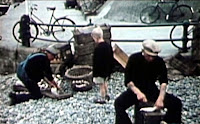The following notes have been collected from Henry’s papers and ‘crab books’ where he recorded numbers and prices for crabs caught and sold.
By the early 1950’s there were fewer than half the number of fishermen at Sheringham, compared to before the war. About 17 boats were fishing full time from the town in 1951, split between the East and West Beaches.
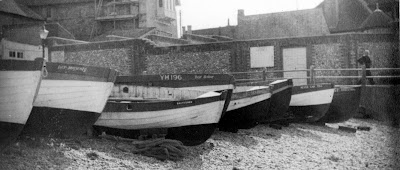 |
| Sheringham, East Beach, early 1950’s: ‘Our Boys’ on the far left |
 |
| Sheringham, East Beach, early 1950’s: ‘Our Boys’ on the far right |
A typical catch per haul would be 800 to 1000 crabs, or 400 to 500 ‘cast’ (pairs), or about 3 - 4 ‘long hundreds’ (120 cast i.e. 240 crabs).
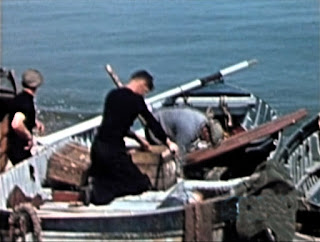 |
| Henry (centre) filling boxes with crabs in ‘Our Boys’ |
The price we got from the fish merchants for a ‘long hundred’ of crabs in the early 1950’s was about £4 [£88 equivalent in 2017]. So in the crabbing season a boat could make, say, £15 a day or up to £90 a working week [£1980 equivalent in 2017]. Of course if there were a glut of crabs the merchants immediately dropped their price and that was that!
Also, there were a lot of demands on that £90 per week before we saw a penny of it. Bait, petrol, fishing gear, boat repairs, rubber thigh boots and yellow ‘oilies’ all took priority.
Bait was the biggest expense, with the crab’s favourite, gurnard, costing us 6 shillings a stone [£1.50 per kg equivalent in 2017].
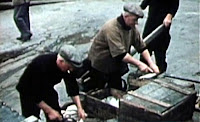
Preparing Bait on the East End Beach, 1950's
Each crab pot cost about £1 to make in those days and with the tows and anchors etc. there was at least £150 ‘investment’ on the sea bed from each boat [over £3000 equivalent in 2017] and all at the mercy of a spell of bad weather.
Someone estimated that these expenses would add up to about £20 per week per boat but this did not include the costs of delivering the crabs and lobsters to the merchants by road or railway, which had be taken out of the earnings as well.
Size restrictions for crabs and lobsters were also being tightened at around this time. Fishery regulations increased the minimum crab size across the shell from 4 ¼ inches [ ~10.5 cm] to 4 ½ inches [ ~11.5 cm]. Similarly minimum lobster size increased from 8 inches [~20.5 cm] to 9 inches [~23cm]. Fisheries officers were on the beach daily to check that the rules were obeyed.
 |
| Jimmy ‘Chibbles’ Bishop |
Then there was the local town council.
Henry kept the following press cutting with his memoirs, about a Sheringham Town Council meeting in the early 1950’s.
Apparently, some councillors, were proposing that the odours from the fishermens’ beaches were a ‘health hazard’ - an idea we thought that went out in Victorian times.
 |
| Jack & Henry Preparing Bait (1950's) |
Sometimes there was a shortage of gurnard and we had to use more expensive flat fish as bait.
 |
| Grey Gurnard |
In 1955 I had my own medical problems with a gurnard but it had nothing to do with “strong smells”.
I pricked my right hand on the spines of a gurnard, the day before the ‘Zor’ rescue on 19 May 1955. The hand became infected and had to be bandaged up. As a result when we returned from the 14 hour rescue of the last four crew of the ‘Zor’, I asked the second mechanic Jimmy ‘Chibbles’ Bishop to take my place in throwing the rope ashore.
 |
| Henry (left) and Jimmy Bishop (right) returning from the ‘Zor’ |
I had my hand bandaged for several weeks. You can tell that any photo was taken in summer 1955 if you see me in it with a bandaged right hand.

The fisherman’s daily routine was governed by the tides. If the tide was in, the boats would be launched from the beach with the everyone helping one another.
When there was a suitable ‘level’ between the swells there would be a shout and the boat would be pushed out by the fishermen usually with the aid of a ‘quant’ or pole.
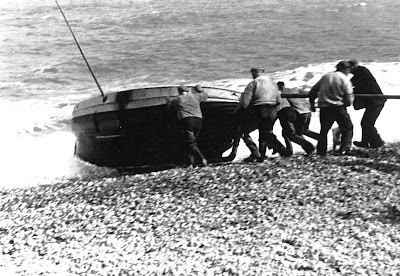 |
| Using a "Quant" to push boats off the beach |
 |
| Using a "Quant" |
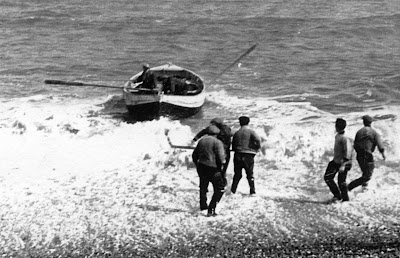 |
| Oars ready in case of engine failure close to the beach |
At other times, crews of the boats worked together sometimes in the early hours of 3 or 4 am ‘skeeting down’ to a low water launch across the sands. By the time the work at sea was done the tide would be in; these times were known as ‘early tides’.
More effort was required when the boats returned to shore. When I was a youngster hand winches, with 5 men on each handle, were used on the East and West End beaches to haul the motor crab boats up.
Before then, lighter sail and oar crab boats were carried across the beach to the water’s edge and launched once the bag of beach stones, ballast, was in. On the return the bag of stones was tipped out and the boats carried across the beach, using the oars through the orruck holes, to above the high water mark.
With the coming of the bigger and heavier motor crab boats, skeets [wooden frame holding two metal rollers] were used, three or four at a time, to move the boats across the sands at low water and up the shingle beach.
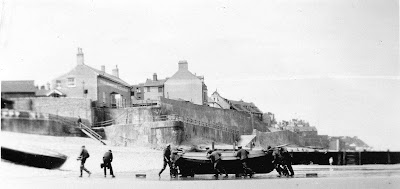 |
| Moving a motor crab boat with skeets, before electric winches were installed |
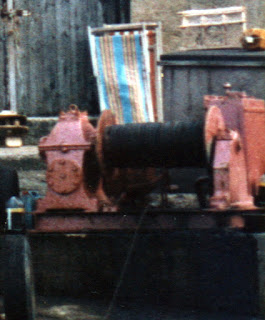 |
| West End Beach Winch |
Not only was the labouring of getting the boats back up the beach reduced, it was also a lot faster.
 |
| East End electric winch recovering ‘Never Can Tell’ in 1955 |
 |
| Henry in the 1950's |
